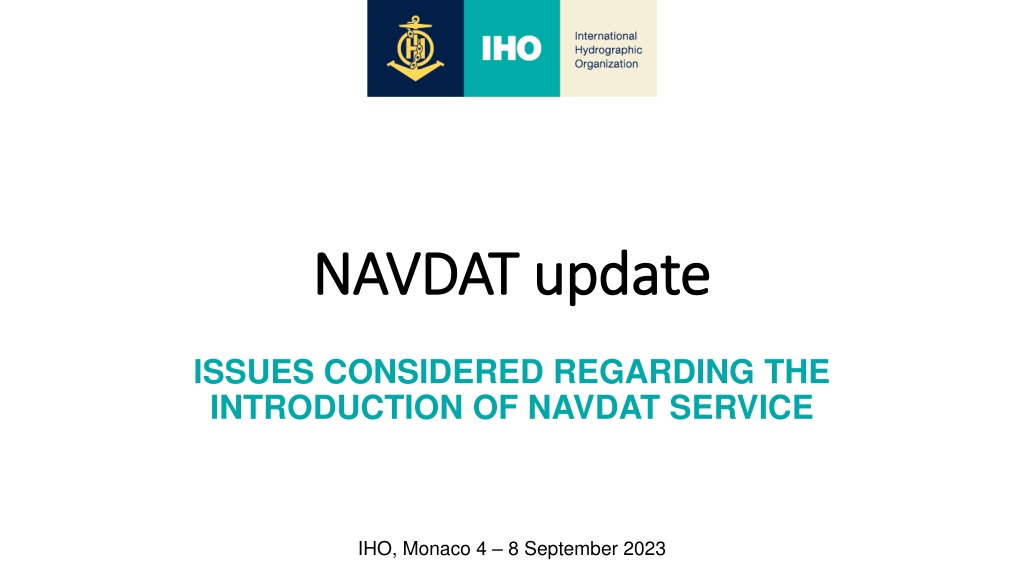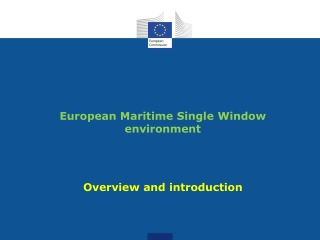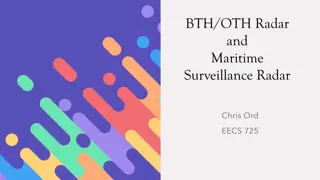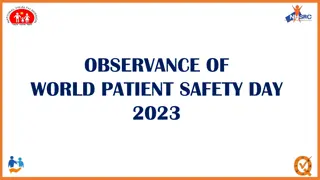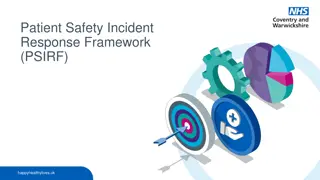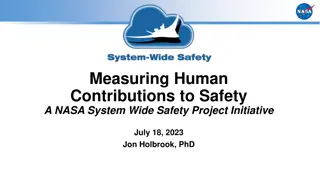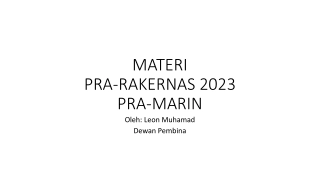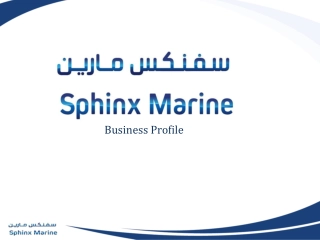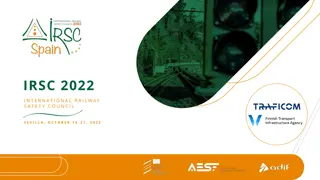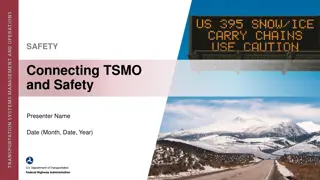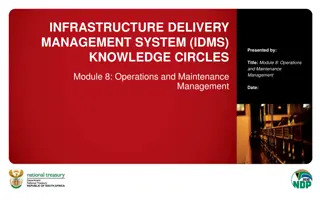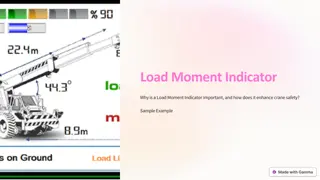Enhancing Maritime Safety Information Delivery with NAVDAT
NAVDAT, a digital system, complements NAVTEX/GMDSS by providing faster data transmission and encryption capabilities. It aims to eventually replace NAVTEX, offering improved broadcast settings for navigational warnings, meteorological forecasts, and ice information. Regulatory amendments are required for a smooth transition, supported by IEC and ITU standards. Testing S-100 data model and developing performance standards are key considerations for integrating NAVDAT into GMDSS.
Enhancing Maritime Safety Information Delivery with NAVDAT
PowerPoint presentation about 'Enhancing Maritime Safety Information Delivery with NAVDAT'. This presentation describes the topic on NAVDAT, a digital system, complements NAVTEX/GMDSS by providing faster data transmission and encryption capabilities. It aims to eventually replace NAVTEX, offering improved broadcast settings for navigational warnings, meteorological forecasts, and ice information. Regulatory amendments are required for a smooth transition, supported by IEC and ITU standards. Testing S-100 data model and developing performance standards are key considerations for integrating NAVDAT into GMDSS.. Download this presentation absolutely free.
Presentation Transcript
NAVDAT update NAVDAT update ISSUES CONSIDERED REGARDING THE INTRODUCTION OF NAVDAT SERVICE IHO, Monaco 4 8 September 2023
1. Identify the areas where NAVDAT can complement NAVTEX/GMDSS in providing maritime safety information to ships at sea and what identified gap(s) it is filling. NAVDAT is a digital system providing greater flow (18 kbit/s to compare with 50 bit/s of NAVTEX) Broadcasting NAVDAT messages can be done by: .1 general broadcast (to all ships); .2 selective broadcast (to ships located in a specific area, or for groups of ships); and .3 dedicated message (according to ship's MMSI). There are possibilities of encrypting sensitive files in the three modes of broadcasting. NAVDAT offers the possibility of operating in Single Frequency Network (SFN) mode. NAVDAT can supersede not only NAVTEX and HF NBDP, but also HF facsimile. IHO, Monaco 4 8 September 2023
2. and if so, what is the timeframe and regulatory amendments required. Determine if the intent is for NAVDAT to eventually replace NAVTEX, Obviously, it will be time to discontinue the old fashion telex display of information to ships by digital information. Modern digital signal processing technology allows faster data transmission and therefore more information to broadcast. Current NAVTEX coast stations encounter difficulties as there is no possibility to allot enough broadcast time to transmit important MSI. In addition, many facilities of NAVTEX coast stations need to be replaced due to their long time in service. It could be considered appropriate to change old NAVTEX coast stations to NAVDAT coast stations, as for the same transmitter can be used to broadcast NAVTEX and NAVDAT messages. In this regard NAVDAT can prepare a smooth transition from NAVTEX to NAVDAT. We can plan between 5 to 10 years a phased out of NAVTEX. IHO, Monaco 4 8 September 2023
3. providing maritime safety information to ships at sea, for navigational warnings, meteorological warnings and forecasts and ice information. Determine if NAVDAT can support the S-100 data model for If S-100 messages can be provided by internet, S-I00 messages can be provided by digital radio. Different type of digital format and size have been already broadcast by NAVDAT, it is a question of broadcast settings that can be automatized for a friendly use. The best would be to test S-100 by NAVDAT as soon as possible. IHO, Monaco 4 8 September 2023
4. (IEC) standards for the integration of NAVDAT into GMDSS. Develop performance (IMO), technical (ITU), test and certification The ITU has prepared different technical recommendations: - In November 2011, Recommendation ITU-R-M 2010, NAVDAT 500 kHz; - In February 2014, Recommendation ITU-R M.2058, NAVDAT HF; and - In November 2018, Report ITU-R M.2443, NAVDAT Guidelines. WRC 19 confirmed the use of all frequency bands for NAVDAT: 500 kHz, 4226 kHz, 6, 8, 12, 16, 18/19, 22 & 25/26 MHz. NCSR WG COM is developing performance standard for NAVDAT receiver and method to determine NAVDAT service area. IEC will develop certification standards based on IMO performance standards. IHO, Monaco 4 8 September 2023
5. include the frequencies of NAVDAT. Finalise amendments to Appendix 15 of the Radio Regulations to The NCSR 10 noted that the ITU World Radio Conference 2023 (WRC 23), to be held from 20 November to 15 December 2023, was expected to consider the inclusion of the NAVDAT MF and HF frequencies into appendix 15 of the Radio Regulations to ensure their protection from harmful interference caused by other services and systems, which would be an important parameter to take into account when finalizing the draft performance standards for NAVDAT. The amendments relate for the inclusion in the Appendix 15 of the RR of the two international frequencies: 500 kHz in the MF band and 4 226 kHz. IHO, Monaco 4 8 September 2023
6. shipborne reception simultaneously supports NAVDAT and NAVTEX in what capacity, i.e., forward and backward compatibility or only backward compatibility. Determine if equipment for shore-based transmission and/or The same NAVDAT transmitter can be used to broadcast NAVTEX and NAVDAT messages. Then a NAVDAT coast station can be use for NAVTEX, but the reverse is of course not possible (to use a NAVTEX coast station for NAVDAT). It would be also possible to receive NAVTEX message on NAVDAT receiver, but comparing the interest of digital messages in different formats, there will be no interest in the end to develop such dual receiver. IHO, Monaco 4 8 September 2023
7. and procedures for the integration process, including a NAVDAT manual and operational implementation plan as a component of the WWNWS and WWMIWS. Engage with the IHO and WMO on the development of guidelines This is exactly the purpose of the draft NAVDAT manual presented at NCSR (see NCSR 10/8 annex 3) to help IHO and WMO to understand the transmission of digital files by NAVDAT. IHO, Monaco 4 8 September 2023
8. NAVDAT into GMDSS. Conduct and evaluate pilot projects to test the integration of China broadcasts digital messages by NAVDAT 500 kHz since 2016. France made measurement of NAVDAT 4 MHz in 2019 with digital files, 2 NAVDAT HF coast stations are planned in France to continue demonstrating the interest to broadcast digital information to ships. IHO, Monaco 4 8 September 2023
9. shore-based personnel. Develop training and certification standards for ship operators and NAVDAT receiver is supposed to be develop for all ships, including fishing vessels and yachts as it is the case for other GMDSS radio equipment. The operation of the receiver should be simple, anyway training should be developed as it is the case for NAVTEX. GMDSS coast station operator's certificate (CSOC) syllabus (COMSAR.1/Circ.33/Rev.1) can be amended with NAVDAT requirement. But model course still need to be developed in general for CSOC. Anyway, ITU documents and the draft NAVDAT manual can help to train shore-based operator for NAVDAT. IHO, Monaco 4 8 September 2023
10. to monitor and evaluate the integration of the NAVDAT system to ensure compliance with standards, guidelines and procedures. Articulate the process for determining service areas and the process for formal recognition of applications. Amend the terms of reference for the NAVTEX Coordinating Panel Though NAVTEX and NAVDAT are two different systems, they are both terrestrial radio systems operating in the same frequency bands and in a broadcast mode. It is hence proposed the extension of the responsibilities of the IMO NAVTEX Coordinating Panel in the draft NAVDAT manual to cover the coordination of NAVDAT coast stations. This arrangement offers the advantage not to create a new IMO body and concentrate the coordination of all terrestrial broadcast system in one panel. IHO, Monaco 4 8 September 2023
11. framework for new terrestrial GMDSS services, such as NAVDAT, including consideration of implementation facilities such as cost? In this regard, who should undertake that recognition process? Does the Organization need to develop a formal recognition issues for shore-based The NAVDAT system, like the NAVTEX system, has been prepared by ITU for the broadcast of maritime safety information. Like any terrestrial radiocommunication system, and in line with SOLAS IV Regulation 5, the implementation of any terrestrial radiocommunication system is at the discretion of Member States. SOLAS IV refers to a recognition process only for mobile satellite services in the GMDSS in Regulation 4-1. The reason for this is that mobile satellite services are operated by private entities which require criteria, procedures and arrangements for the evaluation, recognition, review and oversight. On the contrary, terrestrial radio systems for the maritime mobile service are established by each Contracting Government that undertakes to make available, as it deems practical and necessary, either individually or in cooperation with other Contracting Governments, appropriate shore-based facilities for the maritime mobile service in due regards to ITU and IMO recommendations. IHO, Monaco 4 8 September 2023
